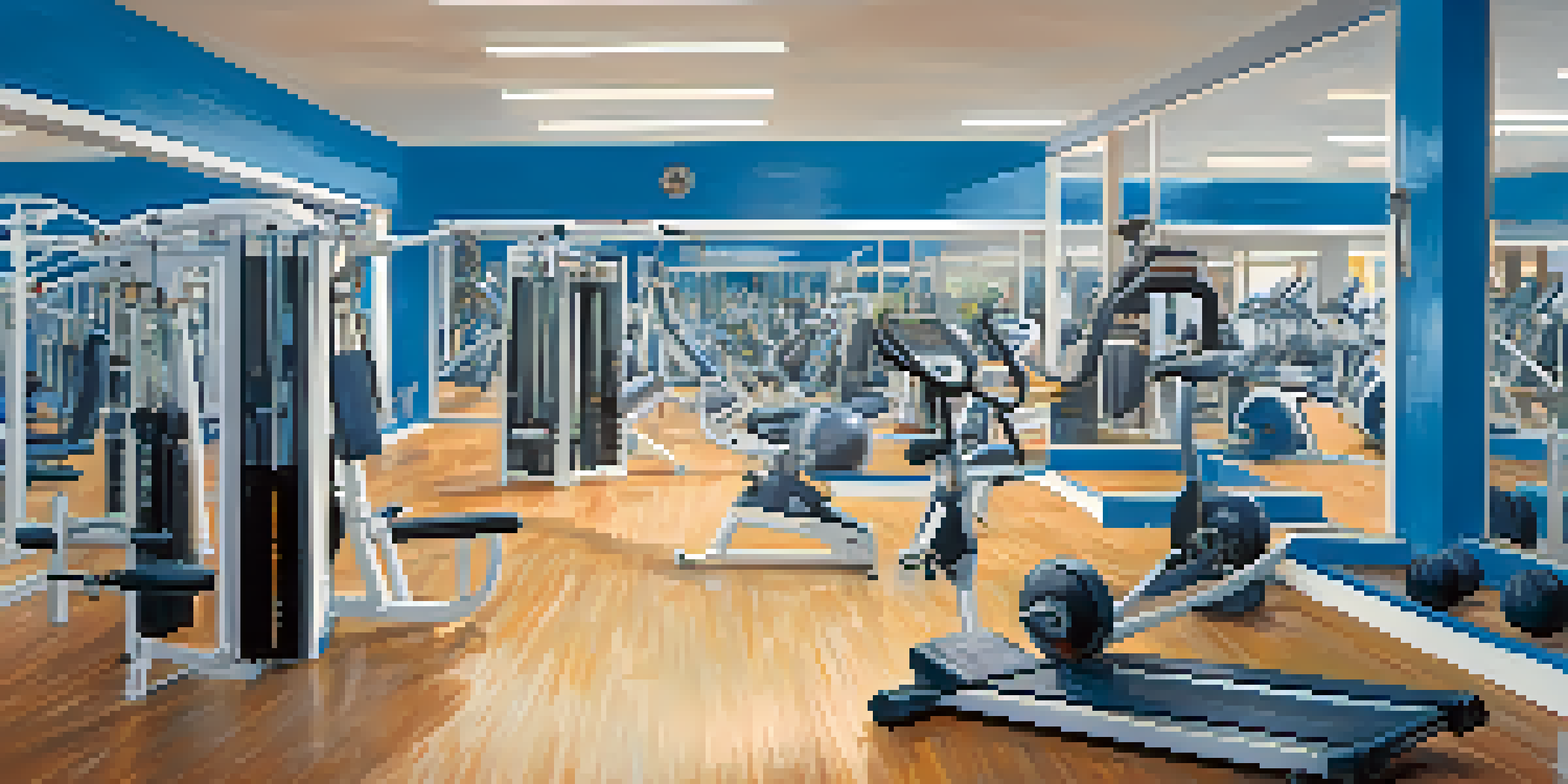Essential Warm-up Routines for Bodybuilders to Enhance Performance

Understanding the Importance of Warm-ups for Bodybuilders
Warm-ups are a crucial part of any workout routine, especially for bodybuilders. They help prepare your muscles and joints for the demands of heavy lifting, reducing the risk of injury. Think of warm-ups as the ignition for your body's engine—without it, you might stall or even damage the vehicle.
An ounce of prevention is worth a pound of cure.
Incorporating a proper warm-up routine can also enhance your overall performance. By gradually increasing your heart rate and circulation, you ensure that your muscles are ready to work hard. This is akin to stretching a rubber band before you snap it; the more prepared it is, the better it performs.
Moreover, warm-ups can improve your mental focus and motivation. They give you a moment to mentally prepare for your workout, setting the tone for a productive session. So, don’t skip this step—your body and mind will thank you!
Dynamic Stretching: A Key Component of Warm-ups
Dynamic stretching involves moving parts of your body through a full range of motion, making it an excellent warm-up technique. This not only increases blood flow to your muscles but also improves flexibility and mobility, which are essential for bodybuilding. Imagine a dancer fluidly moving through space; this is how your body should feel during dynamic stretches.

Some effective dynamic stretches include leg swings, arm circles, and torso twists. These movements mimic the actions you'll perform during your workout, preparing your body for the specific exercises ahead. Just like a rehearsal before a performance, these stretches set the stage for what’s to come.
Warm-ups Prevent Injuries
Incorporating warm-ups prepares your muscles and joints for heavy lifting, significantly reducing the risk of injury.
Incorporating at least 5-10 minutes of dynamic stretching into your warm-up can significantly enhance your performance. It’s a simple yet effective way to ensure your body is primed and ready for the heavy lifts that lie ahead.
Foam Rolling: Release Tension and Enhance Mobility
Foam rolling is another essential warm-up technique that bodybuilders should consider. This practice helps to release muscle tightness and improve blood flow, preparing your body for the stresses of lifting. Think of foam rolling as a massage you give yourself; it feels great and helps your muscles perform better.
The only bad workout is the one that didn't happen.
By targeting specific muscle groups, foam rolling can alleviate soreness and enhance mobility. This is particularly beneficial for areas that tend to hold tension, like the back, quads, and hamstrings. Imagine trying to run a race with tight shoelaces; it just wouldn’t work, right? That’s how your muscles might feel without proper rolling.
Spending just a few minutes rolling out your muscles can make a noticeable difference in how you feel during your workout. It’s a small investment of time that pays off in the form of improved performance and reduced injury risk.
Specific Warm-up Sets: Prepare for Heavy Lifts
Performing specific warm-up sets is a smart strategy for bodybuilders aiming to lift heavy weights. This technique involves doing lighter versions of the exercises you plan to perform, gradually increasing the weight. It’s like filling your tank with a bit of gas before hitting the highway; you need that momentum to go full throttle.
Start with bodyweight or very light sets to get your form right and muscles engaged. For example, if you plan to bench press 200 pounds, begin with 50-100 pounds for a few reps. This progressive approach ensures that your body is accustomed to the movement and ready for the heavier load.
Dynamic Stretching Enhances Performance
Dynamic stretching increases blood flow and flexibility, priming your body for the specific actions you'll perform during your workout.
By the time you reach your working sets, your muscles will be activated and primed for action. This method not only enhances your performance but also reinforces proper technique, which is vital for lifting safely.
Incorporating Mobility Drills for Joint Health
Mobility drills are essential for maintaining joint health, especially for bodybuilders who put their joints under significant stress. These drills help improve the range of motion in your joints, making it easier to perform exercises effectively. Think of mobility as oil for your joints; it helps everything move smoothly.
Common mobility drills include hip circles, ankle rolls, and shoulder dislocations using a resistance band. These exercises can help prevent stiffness and injuries, ensuring that your joints remain healthy throughout your training. Just as you wouldn’t drive a car with rusted hinges, you need to keep your joints moving freely.
Making mobility drills a part of your warm-up routine can set you up for long-term success in bodybuilding. By keeping your joints flexible and strong, you’ll be able to lift heavier and with better form, ultimately leading to better results.
Breath Control: The Overlooked Aspect of Warm-ups
Breath control is often overlooked in warm-up routines, but it plays a vital role in enhancing performance. Proper breathing techniques can help you manage tension and focus during your workouts. Just like a calm sea allows for smoother sailing, controlled breathing can keep your energy steady and your mind clear.
Incorporating deep breathing exercises into your warm-up can help increase oxygen flow to your muscles, allowing for better performance. Try inhaling deeply through your nose, holding for a moment, and exhaling slowly through your mouth. This simple practice can ground you and prepare your body for the challenges ahead.
Breath Control Improves Focus
Practicing breath control during warm-ups enhances mental clarity and energy, leading to a more effective workout session.
By focusing on your breath, you create a connection between your mind and body, which can enhance your overall workout experience. It’s a small adjustment that can lead to significant improvements in your lifting sessions.
Timing Your Warm-up: Finding the Right Balance
Timing your warm-up is crucial; it should be long enough to prepare your body but not so long that you lose focus or energy. Generally, a warm-up of 10-20 minutes is ideal for most bodybuilders. Think of it like a racehorse; you want to get them warmed up without tiring them out before the race begins.
Pay attention to how your body feels during your warm-up. If you feel sufficiently warmed up and ready to lift, you may not need to extend it any further. However, if you feel tight or sluggish, consider adding some extra time to ensure you're ready for your workout.

Ultimately, finding the right balance in timing will help you maximize your performance and minimize the risk of injury. Your warm-up should energize you and set a positive tone for the workout ahead.